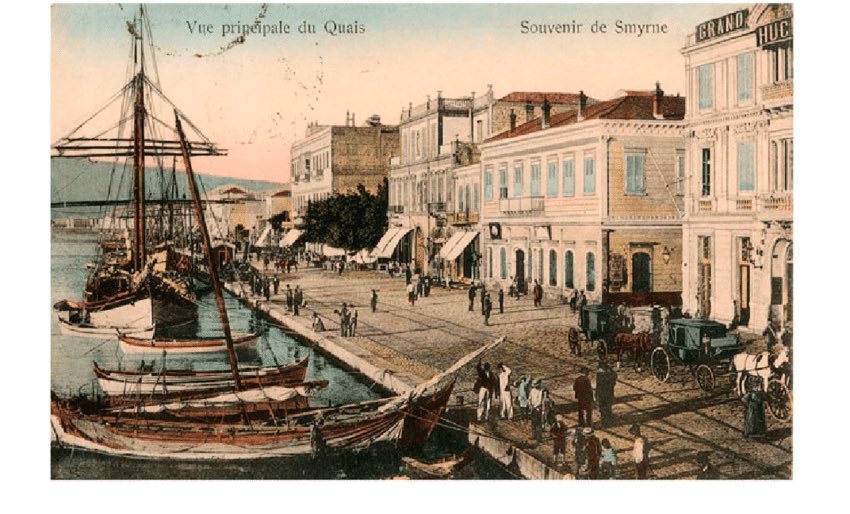On this day: September 13th 1922, Turkish soldiers set fire to Smyrna’s Greek and Armenian quarters and went on a rampage of rape, pillage and mass murder.
🧵The destruction of #Smyrna;
One of the great atrocities of the 20th century.
🧵The destruction of #Smyrna;
One of the great atrocities of the 20th century.

The Great Fire of Smyrna was the peak of the Asia Minor Catastrophe, and the last phase of the Greek genocide, bringing an end to the 3,000-year Greek presence on Anatolia’s Aegean shore and shifting the population ratio between Muslims and non-Muslims.




Before its destruction by the Turks, the great city of Smyrna on the Anatolian coast was one of the world’s richest, most cosmopolitan and ethnically diverse metropolises, containing twice as many Greeks as then lived in Athens.




During the Ottoman period, the Turks referred to Smyrna as Gâvur İzmir (Infidel Smyrna) due to its large Christian population. Of Smyrna’s approximately half-million inhabitants, the city’s 320,000 Greeks dominated the urban center’s cultural and economic life.






Indeed, as the possible birth place of Homer, Greece had a long and deeply-embedded history with this most ancient city. Smyrna was a center of Greek culture for millennia before all traces of Hellenism were destroyed in 1922.




Ataturk’s army entered Smyrna on September 9th, 1922. By September 22nd, Smyrna was unrecognisable. Turkish soldiers torched buildings and set fire to the Greek, Armenian and European sections of Smyrna erasing anything that would remind future generations of their presence.




The Catastrophe of Asia Minor is widely remembered as one of the worst humanitarian crises of the 20th century. As the city burned, Turkish forces continued to ravage the city, looting businesses, and raping and killing thousands more defenceless civilians.




Historical accounts reveal over 120,000 people were slaughtered, 160,000 were driven to other parts of Turkey, and more than 50,000 houses, 24 churches, and 28 schools, banks, consulates, and hospitals were burned.




The entire Greek district was destroyed. Not a single Greek building; no home, church, school, shop, office, factory, business, survived the fire. In contrast, Smyrna’s Turkish quarter & population were completely untouched by the carefully directed and flames of the Turks.




Kemalist military commander Nurettin Paşa summoned the Metropolitan of Smyrna Chrysostomos to the Konak and cried out to a waiting mob to "treat him as he deserves." The mob tore out the Metropolitan's beard, gouged out his eyes with knives and cut off his ears, nose and hands.




For days as the city burned, more than 400,000 Greeks crammed Smyrna’s waterfront to escape from the inferno. An international armada of American, British, French, & Italian warships remained anchored in Smyrna’s port, under orders from their governments to do nothing.




21 allied ships, on orders of their respective governments, anxious to protect oil and trade interests in the area, all watched on passively as thousands of Christians were massacred in cold blood. 

There followed a massive cover-up by tacit agreement of those same Western Allies. The destruction of Smyrna, one of the largest massacres of the early 20th century has subsequently been all but expunged from historical memory.
This brutal attack on the long-standing metropolis of Smyrna resulted in over a million Greek and Armenian refugees, who were forcibly removed from their homeland and were forced to seek refuge in other countries, including the U.S. and Australia. 

Although the obliteration of Smyrna and the decimation & erasure of the city’s Greek population is the most well-known event of the Great Catastrophe, it was just one of many crimes committed by Turkey during that country’s nearly decade-long genocide against the Greek minority. 

From 1914 to 1923 over 1 million Cappadocian, Pontic and Asia Minor Greeks were murdered by Ottoman authorities and over 800,000 are estimated to have been deported.




Whereas up to 2 million Ottoman Greeks lived in Anatolia prior to World War I, there are less than 1,200 Greeks residing in Turkey today.
The EU, US, UK, and the UN have all failed to recognize the Greek Genocide.
The EU, US, UK, and the UN have all failed to recognize the Greek Genocide.

• • •
Missing some Tweet in this thread? You can try to
force a refresh






























